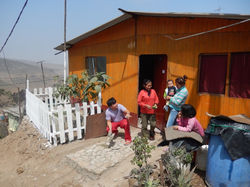
COMMUNITY GARDENS
Winner of the 2013 Public Interest Design – Global Competition
PROJECT INFORMATION
Project Type
Community gardens
Project Location
Lomas de Zapallal, outside of
Lima, Peru
Project Partner
UW Departments of Global Health
and Landscape Architecture; Universidad de San Marcos;
Fogarty International Scholars program;
The communities of Lomas de Zapallal
Project Start Date
2015
Project Team
Ben Spencer
Brian Gerich
David Witte
Jess Smith
Coco Alarcon
Leann Andrews
# of AWB Volunteers
Numerous volunteers + UW students
More Information
The Community Gardens Project is one of several projects AWB-Seattle is partnering with University of Washington to implement in Lomas de Zapallal. Learn more about this project and our partnership with University of Washington! You can read about our background on this project and see the partner projects here.
ABOUT THIS PROJECT
Lima has the lowest green space per capita in South America, and rapid urban expansion is resulting in the destruction of local habitat, erosion, and air pollution.
As Lima’s population continues to grow, water and food shortages will further degrade the region’s few remaining ecologically resilient landscapes and slum dwellers will face increasing hardship. Poor living conditions and environmental degradation are likely to exacerbate health problems including tuberculosis, digestive diseases, malnutrition and stress.
Many of the houses in Eliseo Collazos (and most slums throughout Lima) are constructed with prefabricated wooden panels and other components.
The garden ‘kit of parts’ took its cues from the approach to construction and accommodated a wide range of construction experience amongst project participants. It consisted of low cost, locally sourced per-fabricated components. Standard ‘grey’ infrastructure elements were re-imagined as ‘green’ infrastructure garden elements and informally dubbed ‘re-distributed infrastructure’.
Through a series of workshops residents were given guidance and materials to do their construction at their homes. 29 home gardens were constructed during August and September of 2013.
As a final step of this work a team will continue to monitor the project to assess its impacts. Health and well-being data will be re-collected 6 months and 1 year after garden construction. Comparative PIA workshops will be conducted at 1 year. A local coordinator visits the community periodically to collect garden journals offer assistance as needed.
To see more about this project check out the 2013 Seed Competition Page.
 |  |
|---|---|
 |  |
 |  |
 |  |
 |  |
